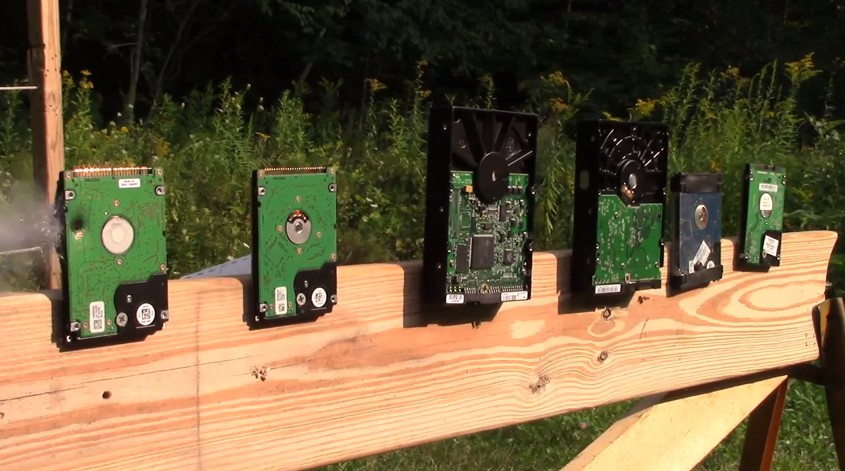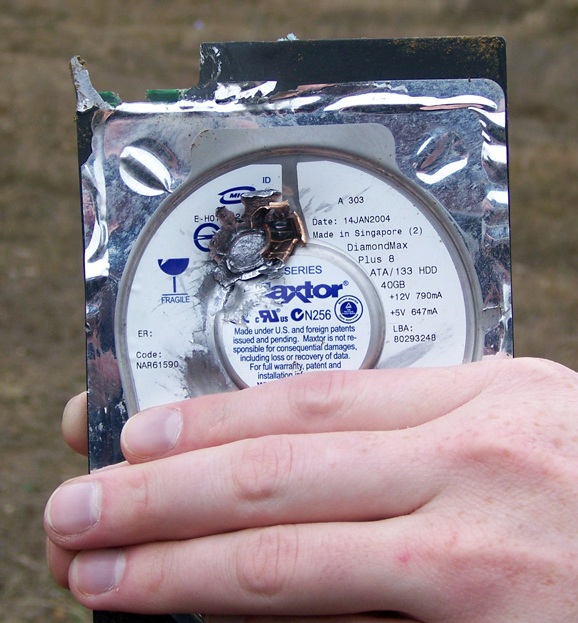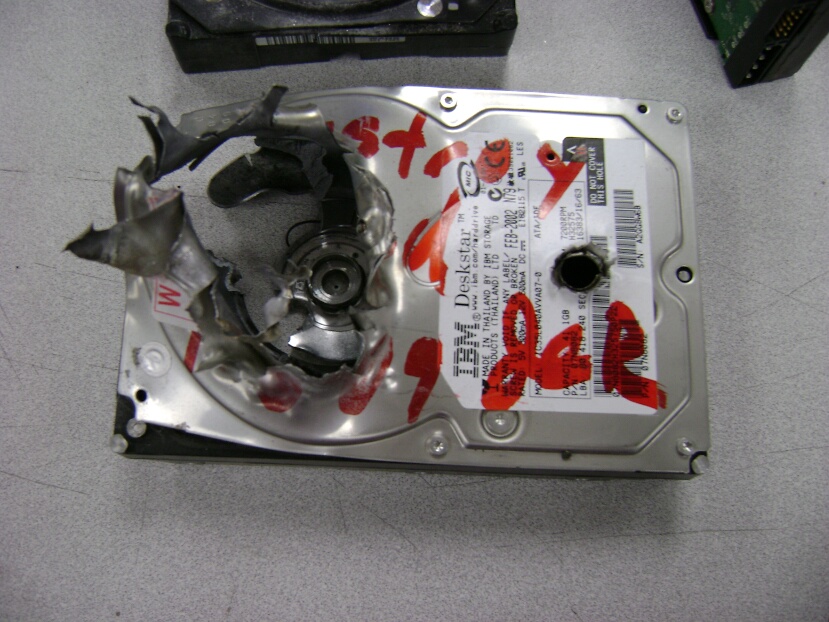This article ( The Right Way To Destroy An Old Hard Drive) got me thinking……
I’m a huge fan of privacy. And any sod that tells me that I don’t need crypto because ‘if you’re not doing anything wrong, then you have nothing to hide’ is a short-sighted statist who will be one of the first ones up against the wall when the revolution gets here.
Will snoop-proof cryptography and secure phones/computers make law enforcement and governments job more difficult? Absolutely. Is that a good enough reason to prevent it’s availability? Absolutely not. Yes, terrorists, murderers, kid diddlers, and all sorts of scum are going to use it. The fact that bad guys use it is not reason enough to keep me from using it.
By and large, I’m a pretty law-abiding guy..in the Heinlein way (“I will accept the rules that you feel necessary to your freedom. I am free, no matter what rules surround me. If I find them tolerable, I tolerate them; if I find them too obnoxious, I break them. I am free because I know that I alone am morally responsible for everything I do.“) But that doesn’t mean I feel anyone…spouses, government, church, my mom….should be able to just go spelunking through my hard drive when they have an itch.
Government is a shoddy creature when it comes to respecting your privacy, but it’s an Einstein-level genius when it comes to violating it. And thats why when you decide it’s time to upgrade your computer, it takes more than a simple wipe to make sure your German dungeon porn, Picard/Riker slash fiction, Katy Perry bootlegs, and .jpgs of that really, really, ill-advised waitress from Buffalo Wild Wings don’t wind up on someone elses computer.
Lots of people say that all you have to do is degausee your drive. Look, I’m not the trusting type. If I degause a drive how do I know it really worked? I’m not cracking my computer open, putting the degaussed drive back in , and then trying to read it. No..the best way is utter destruction. And, fortunately, for guys like you and me, there’s a very convenient method that is just a range trip away.

Seems like a good idea. But, really, you need to sink more than just a few rounds into each one of these.
But you have to remember – you would think that punching a couple holes in a drives platter would be enough. I would too. But I am virtually positive that someone, somewhere, has the technology to ‘skip around’ those damaged parts of the disk and get information. Sure, not all of it, but perhaps enough to be a problem. So…a couple holes ain’t gonna do the trick.
Don’t spare the FMJ. What you want is enough metal-shredding terminal ballistics to remove great gouts of material.
I usually take the drive to the range, stand a few yards back from it, and hammer it with half a mag of .223 or .308 until it looks like some sort of shredded-metal sculpture. Then I twist and break it into a couple different pieces and toss ’em in the dumpster.
I saw on the news that the FBI is looking for the hard drive the San Bernadino shooters used. The feds had sent divers into a pond looking for the drive, which means that they fully expect to be able to recover data from a waterlogged drive…which is reasonable, since water won’t really affect magnetic disks. But you just know those guys have all sortsa technology for recovering data from disks people ‘thought theyd erased’.
I mention this not because you or I are engaged in criminal activities that we need to hide, (Well, I’m not..I dont know what youve been up to), but rather because it’s too easy to take the simple way out, whack the ol’ Western Digital with a hammer a few times, call it good, and toss a drive into the trash that could potentially come back and bite you in the butt.
So…if you got a new computer for Christmas, and youre tossing out that old drive to make new for the new shiny one, do the smart thing and head to the range with it.



If the hard drive is encrypted you do not need to do anything special to destroy it. If you think you do need something special to destroy it, then the encrypted hard drive you use now is also at risk.
The encrypted hard drive I have now is in my possession. The one I just dumped into the dumpster ain’t.
And besides, I’m a belt-and-suspenders kinda guy.
roger, ten-four, affirmative. they can recover info from a burned hard drive, saw them do it. ditto for one hammered and thrown in the river. they even have an algorithm that fills in the lost pieces with “most likely” info by extrapolating from what they CAN find. that was years ago so i can only imagine what they can do now.
oh yeah, the only hard drive i’ve ever heard my leo buddy say “they couldn’t get anything from” was adam lanza’s.
Was he being facetious, or did that little crazy shit lanza actually do something to render his drive unreadable?
Side question: why wouldn’t fire do the job? Isn’t the hard drive itself plastic?
Since hard drives are a form of magnetic memory, and plastic isn’t magnetic, I’d say…no.
Well, whatever the material is, I’m guessing it’s related to the recording tape material in a cassette tape, and that stuff is certainly susceptible to fire.
A “water logged” drive is very easy to recover. The platter area is by necessity sealed against water and air, yes spinning platter drives are air-tight. The read/write head floating over the platter has such a small distance betwixt itself and the platter that even dust could cause the old fashioned “hard drive crash”. (The old crash was the head physically gouging the platter when you hit the drive too hard). So the only thing bad in a “water logged” drive is maybe the disk controller, so you just install a new one and POOF, a readable drive.
Myself I prefer the 5.56 destruction, followed with a hammer, then into the burn barrel. If I remember after that (more likely when I spot the bits left after I empty the barrel) I take it with the other scrap to the local metal scrapper.
Total disassembly. Save the magnets, ’cause they look cool on the ‘fridge. Me and Mr. Cutters then go to town on the platters, with the resulting tiny bits spread out through a LOT of different garbage cans.
But your way is more fun.
There is some interesting video floating around the internet of a British newspaper staff that was compelled to destroy the classified data they had come into possession of. Rather than turn over the drives to the government, the government let them destroy the drives themselves under the watchful eyes of government minders.
The newspaper staff, goggled and gloved up, went at the drives with surface grinders and the government felt this was sufficent.
More interesting is a fellow who was arrested for one thing or another and when the American government searched his computer the found some child porn. He was charged and his defense was that the porn had been accessed accidentally and as soon as he realized what it was he deleted it. The prosecutors said that since they were able to recover it from the drive, it had not been deleted and thus he was still “in possession” of the images.
He was cleared on the porn rap because the court held that the software used by the government to retrieve the deleted images was not readily available to the public. Thus, if the only software that could recover it was RESTRICTED – LEO OR GOVT USE ONLY, then he -had- deleted it.
But yer killing the environmentz…..don’t you care about the little bunnies?!?
I care about the little bunnies enough to make sure that they get plenty of room on the plate next to the mashed potatoes.
Indeed, they are quite delicious, aren’t they? 🙂
I’ve found M2 ball, the AP stuff for a Garand, does an excellent job on hard disks.
Back when I worked for a hush-hush .gov program, here’s how we handled our used disks. Back then, they were disk packs, like layer cakes of magnetic film coated aluminum disks, on a common spindle. The disk packs were removed, and the disks were put through a grinder. Then the “chips” were melted in a furnance. Nobody was putting that data back together.
Run a BIG magnet over it before you go to the range in case it doesn’t make it
Disassemble, pull the platters, either crush the platter or destroy the entire surface of the platter with heavy abrasive down to the substrate. The entire surface must be destroyed since write density is so high these days just a small segment can contain a few Mb of readable data or complete files.
High heat will erase the data. All you need to do is roast the drive until it’s red hot. The “Curie point” — the temperature where a material loses its magnetism — for iron is about 1400F, “cherry red.” For the iron oxides used in magnetic media it’s even lower.
These temperatures are achievable with a torch or a charcoal fire.